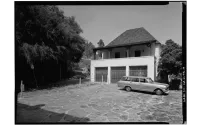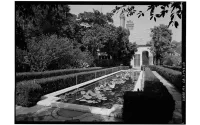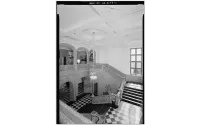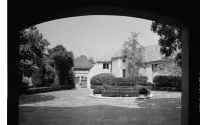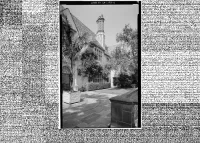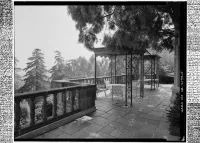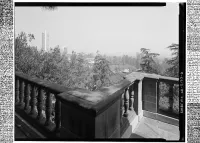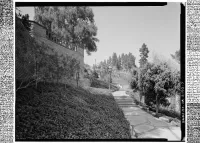Share what you know,
and discover more.
Share what you know,
and discover more.
Sep 30, 2021
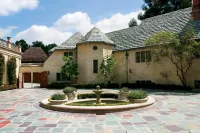
-

- Dave D
Doheny Road – Greystone Manor
By any measure – size, cost, or boldness of vision – Greystone was the grandest estate ever completed in Southern California. The fifty-five room, 46,000 square-foot mansion sat on a lofty knoll at 501 Doheny Road, high above the estates of the mere millionaires on Sunset Boulevard and Lexington Road. It had cost an astounding $4 million upon its 1929 completion, which would have purchased dozens of large homes in the Beverly Hills flats below Sunset Boulevard. The Tudor-style mansion was the centerpiece of the 429-acre Doheny Ranch, which stretched from Doheny Road far up into the hills. Greystone and its immediate grounds could be seen from miles away. The impressive – indeed, forbidding – Greystone was more than an unmistakable emblem of the Doheny family’s unrivalled wealth and authority, which was anchored in Southern California and extended to the national level. The estate’s sheer size and its cost also symbolized the rough-and-tumble world of the early 20th century oil industry in which the Doheny family had made its vast fortune. Then, in 1929, the estate became a crime scene in one of Los Angeles’ most talked about, and most misunderstood, murders. To this day, the estate is wrapped in layers of mystery. It is even said to be haunted by the ghosts left behind in an era of misdeeds. By the early 1920s, Doheny Senior had decided that Ned should build a mansion on the family ranch. He set aside twenty-two acres at the southern end of the property for the residence and grounds. While Greystone’s exterior was grand, the interior was given a pleasing sense of proportion combined with careful craftsmanship, a sense of stateliness, and wealth. The front entrance – a set of plate-glass doors decorated with elaborate hand-wrought iron grillwork – opened onto a marble stair landing. At the right were marble stairs to the second floor. Ahead was a grand marble staircase that led down to the first-floor hallway, which ran perpendicular to the main stairway for the length of the building. At the bottom of the grand staircase was a set of carved and polished oak archways that led into a marble-floor reception room with a fountain. Beyond, through arched French doors, was a terrace with sweeping views of the immense, steeply sloped lawn and the entire Los Angeles basin. But this psychic phenomenon does not seem to be the ghost of either Ned Doheny or Hugh Plunkett who both died so mysteriously in the mansion. Rather, the strange sound that has been heard seems to be that of a woman, weeping inconsolably. Perhaps it is the spirit of a young Lucy Doheny mourning her dead husband, or her family, which rose so high in the world only to be brought down by bold over-reaching and by scandal.
Doheny Road – Greystone Manor
By any measure – size, cost, or boldness of vision – Greystone was the grandest estate ever completed in Southern California. The fifty-five room, 46,000 square-foot mansion sat on a lofty knoll at 501 Doheny Road, high above the estates of the mere millionaires on Sunset Boulevard and Lexington Road. It had cost an astounding $4 million upon its 1929 completion, which would have purchased dozens of large homes in the Beverly Hills flats below Sunset Boulevard. The Tudor-style mansion was the centerpiece of the 429-acre Doheny Ranch, which stretched from Doheny Road far up into the hills. Greystone and its immediate grounds could be seen from miles away. The impressive – indeed, forbidding – Greystone was more than an unmistakable emblem of the Doheny family’s unrivalled wealth and authority, which was anchored in Southern California and extended to the national level. The estate’s sheer size and its cost also symbolized the rough-and-tumble world of the early 20th century oil industry in which the Doheny family had made its vast fortune. Then, in 1929, the estate became a crime scene in one of Los Angeles’ most talked about, and most misunderstood, murders. To this day, the estate is wrapped in layers of mystery. It is even said to be haunted by the ghosts left behind in an era of misdeeds. By the early 1920s, Doheny Senior had decided that Ned should build a mansion on the family ranch. He set aside twenty-two acres at the southern end of the property for the residence and grounds. While Greystone’s exterior was grand, the interior was given a pleasing sense of proportion combined with careful craftsmanship, a sense of stateliness, and wealth. The front entrance – a set of plate-glass doors decorated with elaborate hand-wrought iron grillwork – opened onto a marble stair landing. At the right were marble stairs to the second floor. Ahead was a grand marble staircase that led down to the first-floor hallway, which ran perpendicular to the main stairway for the length of the building. At the bottom of the grand staircase was a set of carved and polished oak archways that led into a marble-floor reception room with a fountain. Beyond, through arched French doors, was a terrace with sweeping views of the immense, steeply sloped lawn and the entire Los Angeles basin. But this psychic phenomenon does not seem to be the ghost of either Ned Doheny or Hugh Plunkett who both died so mysteriously in the mansion. Rather, the strange sound that has been heard seems to be that of a woman, weeping inconsolably. Perhaps it is the spirit of a young Lucy Doheny mourning her dead husband, or her family, which rose so high in the world only to be brought down by bold over-reaching and by scandal.
Sep 30, 2021
Doheny Road – Greystone Manor
By any measure – size, cost, or boldness of vision – Greystone was the grandest estate ever completed in Southern California. The fifty-five room, 46,000 square-foot mansion sat on a lofty knoll at 501 Doheny Road, high above the estates of the mere millionaires on Sunset Boulevard and Lexington Road. It had cost an astounding $4 million upon its 1929 completion, which would have purchased dozens of large homes in the Beverly Hills flats below Sunset Boulevard.The Tudor-style mansion was the centerpiece of the 429-acre Doheny Ranch, which stretched from Doheny Road far up into the hills. Greystone and its immediate grounds could be seen from miles away.
The impressive – indeed, forbidding – Greystone was more than an unmistakable emblem of the Doheny family’s unrivalled wealth and authority, which was anchored in Southern California and extended to the national level. The estate’s sheer size and its cost also symbolized the rough-and-tumble world of the early 20th century oil industry in which the Doheny family had made its vast fortune. Then, in 1929, the estate became a crime scene in one of Los Angeles’ most talked about, and most misunderstood, murders. To this day, the estate is wrapped in layers of mystery. It is even said to be haunted by the ghosts left behind in an era of misdeeds.
By the early 1920s, Doheny Senior had decided that Ned should build a mansion on the family ranch. He set aside twenty-two acres at the southern end of the property for the residence and grounds.
While Greystone’s exterior was grand, the interior was given a pleasing sense of proportion combined with careful craftsmanship, a sense of stateliness, and wealth. The front entrance – a set of plate-glass doors decorated with elaborate hand-wrought iron grillwork – opened onto a marble stair landing. At the right were marble stairs to the second floor. Ahead was a grand marble staircase that led down to the first-floor hallway, which ran perpendicular to the main stairway for the length of the building. At the bottom of the grand staircase was a set of carved and polished oak archways that led into a marble-floor reception room with a fountain. Beyond, through arched French doors, was a terrace with sweeping views of the immense, steeply sloped lawn and the entire Los Angeles basin.
But this psychic phenomenon does not seem to be the ghost of either Ned Doheny or Hugh Plunkett who both died so mysteriously in the mansion. Rather, the strange sound that has been heard seems to be that of a woman, weeping inconsolably. Perhaps it is the spirit of a young Lucy Doheny mourning her dead husband, or her family, which rose so high in the world only to be brought down by bold over-reaching and by scandal.
Posted Date
Nov 02, 2021
Historical Record Date
Sep 30, 2021
Source Name
The Legendary Estates of Beverly Hills
Delete Story
Are you sure you want to delete this story?
Feb 16, 2016
Feb 16, 2016
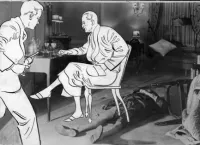
-

- Dave D
Ned Silence (graphic picture warning)
The crime scene drawing shows murder victim Ned Doheny, Jr. in the bedroom of his Los Angeles mansion after being killed by a gunshot to the head, along with a superimposition of where police imagine he was just before he was shot. From the above angle the event looks clinical, but a reverse view reveals an unholy mess, with Doheny's face and robe drenched in blood, and a dark pool spread across the carpet. Out of sight in the hall leading to the bedroom is the body of Hugh Plunkett, Doheny's presumed murderer, dead from a self-inflicted gunshot wound. For a time this was the most famous crime in L.A. history. Doheny was the son of oil tycoon E.L Doheny, who was in trouble for passing bribes to U.S. Secretary of the Interior Albert Fall. The investigation and legal circus, known as the Teapot Dome scandal, had ensnared not just the senior Doheny but Doheny Jr. and Plunkett. They had both been indicted for conveying the dirty money from Doheny Sr. to Secretary Fall. Realistically speaking, there was no serious threat of the Dohenys going to jail. But working class Hugh Plunkett was not a tycoon nor a tycoon's son, which meant for him the possibility of incarceration was real. When Jr. was offered immunity and Plunkett was not, their close friendship began to fray. Plunkett's growing instability spawned attempts to get him into a mental facility—whether to save his mind or save him from testifying remains a subject of debate—but it never happend. Today in 1929 he visited the Doheny mansion to talk with his pal Ned and hours later the result is what you see in the crime scene photos. There's much more to the case—rumors of a sexual relationship between Doheny Jr. and Plunkett, rumors that Doheny Sr. pulled the trigger on both men, etc.—but we'll leave all that aside. The truly interested can find at least a dozen websites that dig into every aspect of the case. We just wanted to show you the photo illustration, which is yet another police photo from the University of Southern California digital archive.
Ned Silence (graphic picture warning)
The crime scene drawing shows murder victim Ned Doheny, Jr. in the bedroom of his Los Angeles mansion after being killed by a gunshot to the head, along with a superimposition of where police imagine he was just before he was shot. From the above angle the event looks clinical, but a reverse view reveals an unholy mess, with Doheny's face and robe drenched in blood, and a dark pool spread across the carpet. Out of sight in the hall leading to the bedroom is the body of Hugh Plunkett, Doheny's presumed murderer, dead from a self-inflicted gunshot wound. For a time this was the most famous crime in L.A. history. Doheny was the son of oil tycoon E.L Doheny, who was in trouble for passing bribes to U.S. Secretary of the Interior Albert Fall. The investigation and legal circus, known as the Teapot Dome scandal, had ensnared not just the senior Doheny but Doheny Jr. and Plunkett. They had both been indicted for conveying the dirty money from Doheny Sr. to Secretary Fall. Realistically speaking, there was no serious threat of the Dohenys going to jail. But working class Hugh Plunkett was not a tycoon nor a tycoon's son, which meant for him the possibility of incarceration was real. When Jr. was offered immunity and Plunkett was not, their close friendship began to fray. Plunkett's growing instability spawned attempts to get him into a mental facility—whether to save his mind or save him from testifying remains a subject of debate—but it never happend. Today in 1929 he visited the Doheny mansion to talk with his pal Ned and hours later the result is what you see in the crime scene photos. There's much more to the case—rumors of a sexual relationship between Doheny Jr. and Plunkett, rumors that Doheny Sr. pulled the trigger on both men, etc.—but we'll leave all that aside. The truly interested can find at least a dozen websites that dig into every aspect of the case. We just wanted to show you the photo illustration, which is yet another police photo from the University of Southern California digital archive.
Ned Silence (graphic picture warning)
The crime scene drawing shows murder victim Ned Doheny, Jr. in the bedroom of his Los Angeles mansion after being killed by a gunshot to the head, along with a superimposition of where police imagine he was just before he was shot. From the above angle the event looks clinical, but a reverse view reveals an unholy mess, with Doheny's face and robe drenched in blood, and a dark pool spread across the carpet.Out of sight in the hall leading to the bedroom is the body of Hugh Plunkett, Doheny's presumed murderer, dead from a self-inflicted gunshot wound. For a time this was the most famous crime in L.A. history. Doheny was the son of oil tycoon E.L Doheny, who was in trouble for passing bribes to U.S. Secretary of the Interior Albert Fall. The investigation and legal circus, known as the Teapot Dome scandal, had ensnared not just the senior Doheny but Doheny Jr. and Plunkett. They had both been indicted for conveying the dirty money from Doheny Sr. to Secretary Fall.
Realistically speaking, there was no serious threat of the Dohenys going to jail. But working class Hugh Plunkett was not a tycoon nor a tycoon's son, which meant for him the possibility of incarceration was real. When Jr. was offered immunity and Plunkett was not, their close friendship began to fray. Plunkett's growing instability spawned attempts to get him into a mental facility—whether to save his mind or save him from testifying remains a subject of debate—but it never happend. Today in 1929 he visited the Doheny mansion to talk with his pal Ned and hours later the result is what you see in the crime scene photos.
There's much more to the case—rumors of a sexual relationship between Doheny Jr. and Plunkett, rumors that Doheny Sr. pulled the trigger on both men, etc.—but we'll leave all that aside. The truly interested can find at least a dozen websites that dig into every aspect of the case. We just wanted to show you the photo illustration, which is yet another police photo from the University of Southern California digital archive.
Posted Date
Nov 02, 2021
Historical Record Date
Feb 16, 2016
Source Name
Pulp International
Delete Story
Are you sure you want to delete this story?
Nov 03, 1965

-

- Catherine Taylor
Greystone is Rescued
The year of 1965 was pivotal for Greystone. It was in danger of being razed for a residential subdivision. Its grounds were considered a fire hazard, maintenance not being kept up by the Chicago corporation that owned it. The land was prime real estate for a new reservoir, which the city desperately needed. There was the question of what could be done with it if it was to be preserved. A group called the Citizens for Greystone was formed to push the city of Beverly Hills to purchase the property. At last purchase of the property was approved by the voters of Beverly Hills. The city made negotiations with the Park Grey Corporation and acquired Greystone.
Greystone is Rescued
The year of 1965 was pivotal for Greystone. It was in danger of being razed for a residential subdivision. Its grounds were considered a fire hazard, maintenance not being kept up by the Chicago corporation that owned it. The land was prime real estate for a new reservoir, which the city desperately needed. There was the question of what could be done with it if it was to be preserved. A group called the Citizens for Greystone was formed to push the city of Beverly Hills to purchase the property. At last purchase of the property was approved by the voters of Beverly Hills. The city made negotiations with the Park Grey Corporation and acquired Greystone.
Nov 03, 1965
Greystone is Rescued
The year of 1965 was pivotal for Greystone. It was in danger of being razed for a residential subdivision. Its grounds were considered a fire hazard, maintenance not being kept up by the Chicago corporation that owned it. The land was prime real estate for a new reservoir, which the city desperately needed. There was the question of what could be done with it if it was to be preserved. A group called the Citizens for Greystone was formed to push the city of Beverly Hills to purchase the property.At last purchase of the property was approved by the voters of Beverly Hills. The city made negotiations with the Park Grey Corporation and acquired Greystone.
Posted Date
Jul 03, 2025
Historical Record Date
Nov 03, 1965
Source Name
The Los Angeles Times
Document Source
Source Website
Delete Story
Are you sure you want to delete this story?
Oct 05, 1965
Oct 05, 1965
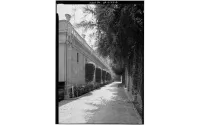
-

- Dave D
Doheny Mansion in Beverly Hills
- Significance: A huge eclectic mansion that combines Gothic and Classical motifs, Greystone was built by oilman Edward L. Doheny as a gift for his son. The house has excellent marble and carved oak details, palatial rooms, and a terrace overlooking Los Angeles. - Survey number: HABS CA-2193 - Building/structure dates: 1929 Initial Construction
Doheny Mansion in Beverly Hills
- Significance: A huge eclectic mansion that combines Gothic and Classical motifs, Greystone was built by oilman Edward L. Doheny as a gift for his son. The house has excellent marble and carved oak details, palatial rooms, and a terrace overlooking Los Angeles. - Survey number: HABS CA-2193 - Building/structure dates: 1929 Initial Construction
Doheny Mansion in Beverly Hills
- Significance: A huge eclectic mansion that combines Gothic and Classical motifs, Greystone was built by oilman Edward L. Doheny as a gift for his son. The house has excellent marble and carved oak details, palatial rooms, and a terrace overlooking Los Angeles.- Survey number: HABS CA-2193
- Building/structure dates: 1929 Initial Construction
Posted Date
Nov 02, 2021
Historical Record Date
Oct 05, 1965
Source Name
Library of Congress
Source Website
Delete Story
Are you sure you want to delete this story?
Oct 05, 1965
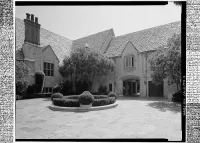
-

- Dave D
Doheny Mansion in Beverly Hills
- Significance: A huge eclectic mansion which combines Gothic and Classical motifs, Greystone was built by oilman Edward L. Doheny as a gift for his son. The house has excellent marble and carved oak details, palatial rooms, and a terrace overlooking Los Angeles. - Survey number: HABS CA-2193 - Building/structure dates: 1929 Initial Construction
Doheny Mansion in Beverly Hills
- Significance: A huge eclectic mansion which combines Gothic and Classical motifs, Greystone was built by oilman Edward L. Doheny as a gift for his son. The house has excellent marble and carved oak details, palatial rooms, and a terrace overlooking Los Angeles. - Survey number: HABS CA-2193 - Building/structure dates: 1929 Initial Construction
Oct 05, 1965
Doheny Mansion in Beverly Hills
- Significance: A huge eclectic mansion which combines Gothic and Classical motifs, Greystone was built by oilman Edward L. Doheny as a gift for his son. The house has excellent marble and carved oak details, palatial rooms, and a terrace overlooking Los Angeles.- Survey number: HABS CA-2193
- Building/structure dates: 1929 Initial Construction
Posted Date
Nov 02, 2021
Historical Record Date
Oct 05, 1965
Source Name
Library of Congress
Source Website
Delete Story
Are you sure you want to delete this story?
Mar 15, 1964
Mar 15, 1964

-

- Catherine Taylor
Greystone in Trouble
For 10 years the mansion remained alone, deserted. The purchaser who had bought Greystone from the Doheny family never moved into it, so it remained in the hands of the Chicago firm Park Grey, Inc. Its only regular visitors were caretakers, and the occasional gardener. At times it was used as a movie location. Some vandalism occurred. It was in danger of being demolished--the land would be used for a residential subdivision. Such was the fate that had befallen many of the fellow mansions from the time period.
Greystone in Trouble
For 10 years the mansion remained alone, deserted. The purchaser who had bought Greystone from the Doheny family never moved into it, so it remained in the hands of the Chicago firm Park Grey, Inc. Its only regular visitors were caretakers, and the occasional gardener. At times it was used as a movie location. Some vandalism occurred. It was in danger of being demolished--the land would be used for a residential subdivision. Such was the fate that had befallen many of the fellow mansions from the time period.
Greystone in Trouble
For 10 years the mansion remained alone, deserted. The purchaser who had bought Greystone from the Doheny family never moved into it, so it remained in the hands of the Chicago firm Park Grey, Inc.Its only regular visitors were caretakers, and the occasional gardener. At times it was used as a movie location. Some vandalism occurred.
It was in danger of being demolished--the land would be used for a residential subdivision. Such was the fate that had befallen many of the fellow mansions from the time period.
Posted Date
Jul 03, 2025
Historical Record Date
Mar 15, 1964
Source Name
The Los Angeles Times
Document Source
Source Website
Delete Story
Are you sure you want to delete this story?
Apr 03, 1937

-

- Catherine Taylor
Lucy Doheny Weds
In March of 1937 Lucy "Dickey Dell" Doheny, daughter of the murdered Ned Doheny, announced her intention to marry Waldeman Van Cott Niven. The marriage was performed at Greystone. Sparks from an incinerator at the marriage rehearsal caused the wedding canopy to be destroyed by fire, but workmen worked to rebuild it in time for the main event!
Lucy Doheny Weds
In March of 1937 Lucy "Dickey Dell" Doheny, daughter of the murdered Ned Doheny, announced her intention to marry Waldeman Van Cott Niven. The marriage was performed at Greystone. Sparks from an incinerator at the marriage rehearsal caused the wedding canopy to be destroyed by fire, but workmen worked to rebuild it in time for the main event!
Apr 03, 1937
Lucy Doheny Weds
In March of 1937 Lucy "Dickey Dell" Doheny, daughter of the murdered Ned Doheny, announced her intention to marry Waldeman Van Cott Niven. The marriage was performed at Greystone.Sparks from an incinerator at the marriage rehearsal caused the wedding canopy to be destroyed by fire, but workmen worked to rebuild it in time for the main event!
Posted Date
Jul 01, 2025
Historical Record Date
Apr 03, 1937
Source Name
Los Angeles Evening Citizen
Document Source
Source Website
Delete Story
Are you sure you want to delete this story?
Feb 14, 1932
Feb 14, 1932

-

- Catherine Taylor
Mrs. Lucy Smith Doheny Weds
A few years after the death of her husband, Ned Doheny, his widow filed a notice of intention to wed Leigh McMaster Battson. The marriage was scheduled to take place in the "English drawing room of Mrs. Doheny's home in Beverly Hills", and the couple would continue to live there until 1955, when they moved to a smaller home.
Mrs. Lucy Smith Doheny Weds
A few years after the death of her husband, Ned Doheny, his widow filed a notice of intention to wed Leigh McMaster Battson. The marriage was scheduled to take place in the "English drawing room of Mrs. Doheny's home in Beverly Hills", and the couple would continue to live there until 1955, when they moved to a smaller home.
Mrs. Lucy Smith Doheny Weds
A few years after the death of her husband, Ned Doheny, his widow filed a notice of intention to wed Leigh McMaster Battson. The marriage was scheduled to take place in the "English drawing room of Mrs. Doheny's home in Beverly Hills", and the couple would continue to live there until 1955, when they moved to a smaller home.Posted Date
Jul 01, 2025
Historical Record Date
Feb 14, 1932
Source Name
Wichita Falls Times
Document Source
Source Website
Delete Story
Are you sure you want to delete this story?
Mar 29, 1931

-

- Catherine Taylor
Life in the Mansion Moves On
After the scandalous murder of 1929, life went on in Greystone. Ned Doheny’s wife Mrs. Lucy Smith Doheny and his five children continued to live in the palatial home. His daughter, Lucy Estelle Doheny, also known by the nickname Dickey Dell, became a popular debutante, hosting several social events.
Life in the Mansion Moves On
After the scandalous murder of 1929, life went on in Greystone. Ned Doheny’s wife Mrs. Lucy Smith Doheny and his five children continued to live in the palatial home. His daughter, Lucy Estelle Doheny, also known by the nickname Dickey Dell, became a popular debutante, hosting several social events.
Mar 29, 1931
Life in the Mansion Moves On
After the scandalous murder of 1929, life went on in Greystone. Ned Doheny’s wife Mrs. Lucy Smith Doheny and his five children continued to live in the palatial home. His daughter, Lucy Estelle Doheny, also known by the nickname Dickey Dell, became a popular debutante, hosting several social events.Posted Date
Jun 30, 2025
Historical Record Date
Mar 29, 1931
Source Name
The Los Angeles Times
Document Source
Source Website
Delete Story
Are you sure you want to delete this story?
Feb 16, 1929
Feb 16, 1929

-

- Catherine Taylor
MURDER!
Greystone was struck by scandal on the night of February 16. Ned Doheny, E. L. Doheny’s only child, had been involved in a murder-suicide when his secretary and friend Hugh Plunkett shot him, then turned the gun on himself. The case was closed after only a couple of days. Differing stories, movement of evidence, and unclear motives have captured the imagination of true crime buffs. Was Ned murdered because Plunkett suffered a nervous breakdown? Were they secret lovers in an argument? Did the incident have anything to do with the upcoming trial in which Ned and Plunkett would both testify regarding bribes they had paid on behalf of the senior Doheny? Clues abound but the true answer will probably never be known.
MURDER!
Greystone was struck by scandal on the night of February 16. Ned Doheny, E. L. Doheny’s only child, had been involved in a murder-suicide when his secretary and friend Hugh Plunkett shot him, then turned the gun on himself. The case was closed after only a couple of days. Differing stories, movement of evidence, and unclear motives have captured the imagination of true crime buffs. Was Ned murdered because Plunkett suffered a nervous breakdown? Were they secret lovers in an argument? Did the incident have anything to do with the upcoming trial in which Ned and Plunkett would both testify regarding bribes they had paid on behalf of the senior Doheny? Clues abound but the true answer will probably never be known.
MURDER!
Greystone was struck by scandal on the night of February 16. Ned Doheny, E. L. Doheny’s only child, had been involved in a murder-suicide when his secretary and friend Hugh Plunkett shot him, then turned the gun on himself. The case was closed after only a couple of days.Differing stories, movement of evidence, and unclear motives have captured the imagination of true crime buffs. Was Ned murdered because Plunkett suffered a nervous breakdown? Were they secret lovers in an argument? Did the incident have anything to do with the upcoming trial in which Ned and Plunkett would both testify regarding bribes they had paid on behalf of the senior Doheny? Clues abound but the true answer will probably never be known.
Posted Date
Jun 30, 2025
Historical Record Date
Feb 16, 1929
Source Name
The Fresno Morning Republican ; The Sacramento Bee ; The San Francisco Examiner
Document Source
Source Website
Delete Story
Are you sure you want to delete this story?
Feb 16, 1929
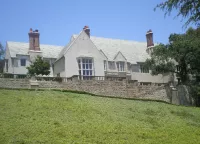
-

- Dave D
Scandal at Greystone
On February 16, 1929, four months after Ned Doheny, his wife Lucy, and their five children moved into Greystone, Doheny died in a guest bedroom in a murder-suicide with his secretary, Hugh Plunkett. The official story indicated that Plunkett murdered Doheny either because of a "nervous disorder" or because he was angry over not receiving a raise. Others point out that Doheny's gun was the murder weapon and that Doheny was not buried in Los Angeles' Calvary Cemetery, a Catholic cemetery, with the rest of his family, indicating he had committed suicide. Both men are buried at Forest Lawn Memorial Park, Glendale, within a few hundred yards of each other. Both were involved in the trial of Doheny's father in the Teapot Dome scandal. Doheny's widow, Lucy, remarried and lived in the house until 1955, when she sold the grounds to Paul Trousdale, who developed it into Trousdale Estates and sold the mansion to Chicago industrialist Henry Crown, who rented it to film studios. In 1963 Crown planned to subdivide the property and demolish the mansion. Beverly Hills stopped the demolition by purchasing the mansion in 1965. The estate became a city park on September 16, 1971, and on April 23, 1976 was added to the National Register of Historic Places. The city leased the mansion to the American Film Institute from 1965 to 1982 for $1 per year, hoping the institute would pay for repairs and upkeep.
Scandal at Greystone
On February 16, 1929, four months after Ned Doheny, his wife Lucy, and their five children moved into Greystone, Doheny died in a guest bedroom in a murder-suicide with his secretary, Hugh Plunkett. The official story indicated that Plunkett murdered Doheny either because of a "nervous disorder" or because he was angry over not receiving a raise. Others point out that Doheny's gun was the murder weapon and that Doheny was not buried in Los Angeles' Calvary Cemetery, a Catholic cemetery, with the rest of his family, indicating he had committed suicide. Both men are buried at Forest Lawn Memorial Park, Glendale, within a few hundred yards of each other. Both were involved in the trial of Doheny's father in the Teapot Dome scandal. Doheny's widow, Lucy, remarried and lived in the house until 1955, when she sold the grounds to Paul Trousdale, who developed it into Trousdale Estates and sold the mansion to Chicago industrialist Henry Crown, who rented it to film studios. In 1963 Crown planned to subdivide the property and demolish the mansion. Beverly Hills stopped the demolition by purchasing the mansion in 1965. The estate became a city park on September 16, 1971, and on April 23, 1976 was added to the National Register of Historic Places. The city leased the mansion to the American Film Institute from 1965 to 1982 for $1 per year, hoping the institute would pay for repairs and upkeep.
Feb 16, 1929
Scandal at Greystone
On February 16, 1929, four months after Ned Doheny, his wife Lucy, and their five children moved into Greystone, Doheny died in a guest bedroom in a murder-suicide with his secretary, Hugh Plunkett. The official story indicated that Plunkett murdered Doheny either because of a "nervous disorder" or because he was angry over not receiving a raise. Others point out that Doheny's gun was the murder weapon and that Doheny was not buried in Los Angeles' Calvary Cemetery, a Catholic cemetery, with the rest of his family, indicating he had committed suicide. Both men are buried at Forest Lawn Memorial Park, Glendale, within a few hundred yards of each other. Both were involved in the trial of Doheny's father in the Teapot Dome scandal.Doheny's widow, Lucy, remarried and lived in the house until 1955, when she sold the grounds to Paul Trousdale, who developed it into Trousdale Estates and sold the mansion to Chicago industrialist Henry Crown, who rented it to film studios. In 1963 Crown planned to subdivide the property and demolish the mansion. Beverly Hills stopped the demolition by purchasing the mansion in 1965. The estate became a city park on September 16, 1971, and on April 23, 1976 was added to the National Register of Historic Places. The city leased the mansion to the American Film Institute from 1965 to 1982 for $1 per year, hoping the institute would pay for repairs and upkeep.
Posted Date
Nov 02, 2021
Historical Record Date
Feb 16, 1929
Source Name
Wikipedia
Source Website
Delete Story
Are you sure you want to delete this story?
Sep 01, 1928
Sep 01, 1928

-

- Catherine Taylor
Ned Doheny and Family Move In
E. L. Doheny’s son, Ned, and his family moved into Greystone although final construction on the huge mansion wouldn’t be completed until 1930. The original cost to build was over $3,000,000 dollars, or over $56,000,000 dollars today. The home boasted 55 rooms, as well as a bowling alley, a private switchboard, a movie theater. There were also secret passages, and a hidden bar and other nooks for storing alcohol, prohibition being enforced in the United States at the time.
Ned Doheny and Family Move In
E. L. Doheny’s son, Ned, and his family moved into Greystone although final construction on the huge mansion wouldn’t be completed until 1930. The original cost to build was over $3,000,000 dollars, or over $56,000,000 dollars today. The home boasted 55 rooms, as well as a bowling alley, a private switchboard, a movie theater. There were also secret passages, and a hidden bar and other nooks for storing alcohol, prohibition being enforced in the United States at the time.
Ned Doheny and Family Move In
E. L. Doheny’s son, Ned, and his family moved into Greystone although final construction on the huge mansion wouldn’t be completed until 1930. The original cost to build was over $3,000,000 dollars, or over $56,000,000 dollars today.The home boasted 55 rooms, as well as a bowling alley, a private switchboard, a movie theater. There were also secret passages, and a hidden bar and other nooks for storing alcohol, prohibition being enforced in the United States at the time.
Posted Date
Jun 30, 2025
Historical Record Date
Sep 01, 1928
Source Name
Library of Congress, Photos from Survey HABS CA-2193
Delete Story
Are you sure you want to delete this story?
Feb 15, 1927

-

- Catherine Taylor
Construction Begins
Construction of a grand mansion began on a parcel of land that oil baron Edward L. Doheny gave to his son as a wedding gift. The home was designed by Gordon B. Kaufman who would be known for his work on the Hoover Dam as well as other notable structures. The construction on the house would not be completed until 1930.
Construction Begins
Construction of a grand mansion began on a parcel of land that oil baron Edward L. Doheny gave to his son as a wedding gift. The home was designed by Gordon B. Kaufman who would be known for his work on the Hoover Dam as well as other notable structures. The construction on the house would not be completed until 1930.
Feb 15, 1927
Construction Begins
Construction of a grand mansion began on a parcel of land that oil baron Edward L. Doheny gave to his son as a wedding gift. The home was designed by Gordon B. Kaufman who would be known for his work on the Hoover Dam as well as other notable structures.The construction on the house would not be completed until 1930.
Posted Date
Jun 30, 2025
Historical Record Date
Feb 15, 1927
Delete Story
Are you sure you want to delete this story?
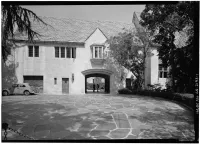
-

- Marley Zielike
Doheny Mansion, 501 Doheny Rd, Beverly Hills, Los Angeles County, CA
A huge eclectic mansion which combines Gothic and Classical motifs, Greystone was built by oilman Edward L. Doheny as a gift for his son. The house has excellent marble and carved oak details, palatial rooms, and a terrace overlooking Los Angeles.
Doheny Mansion, 501 Doheny Rd, Beverly Hills, Los Angeles County, CA
A huge eclectic mansion which combines Gothic and Classical motifs, Greystone was built by oilman Edward L. Doheny as a gift for his son. The house has excellent marble and carved oak details, palatial rooms, and a terrace overlooking Los Angeles.
Doheny Mansion, 501 Doheny Rd, Beverly Hills, Los Angeles County, CA
A huge eclectic mansion which combines Gothic and Classical motifs, Greystone was built by oilman Edward L. Doheny as a gift for his son. The house has excellent marble and carved oak details, palatial rooms, and a terrace overlooking Los Angeles.Posted Date
Sep 27, 2021
Source Name
Library of Congress
Source Website
Delete Story
Are you sure you want to delete this story?


